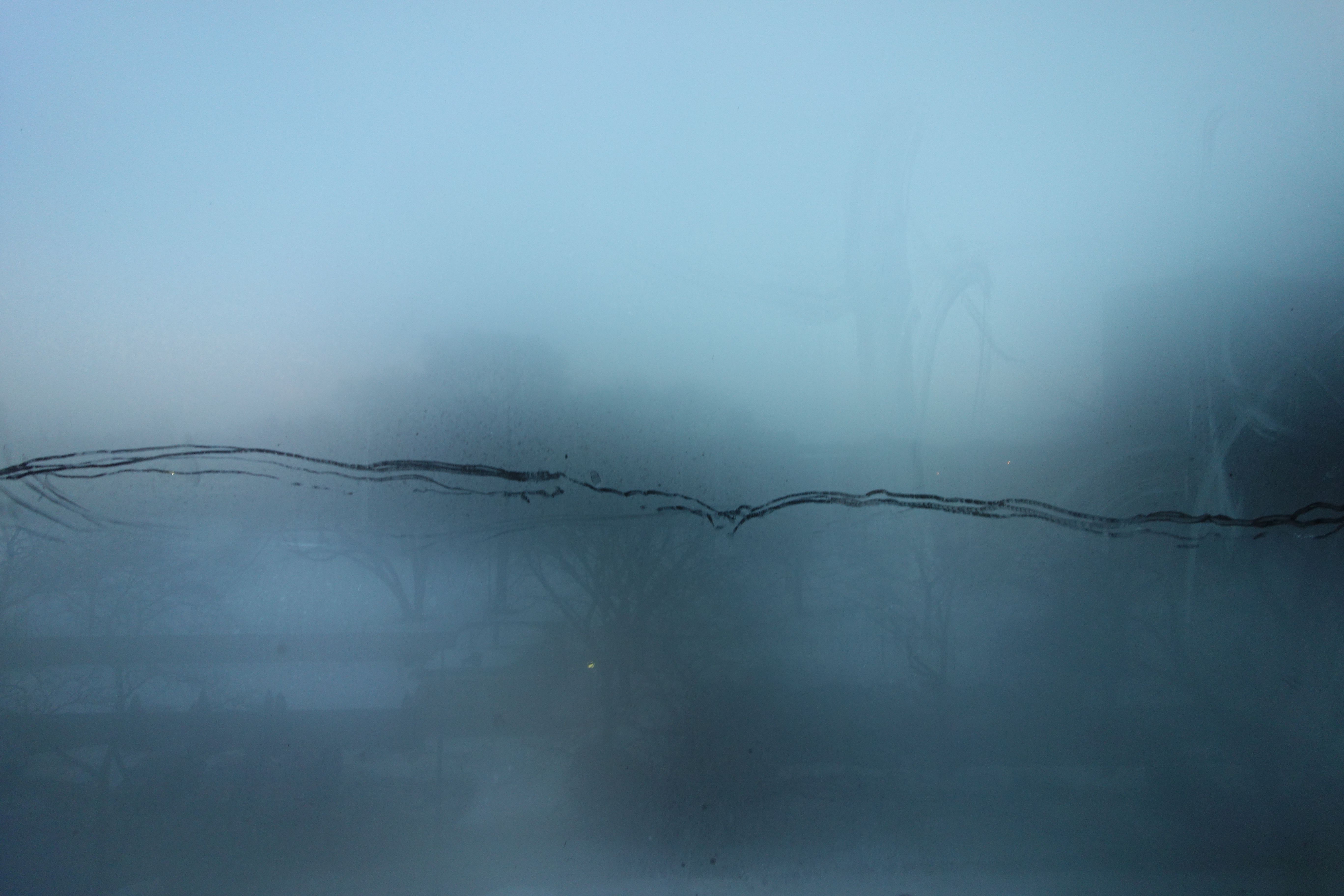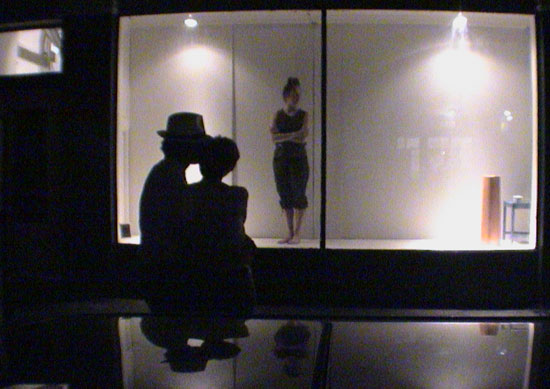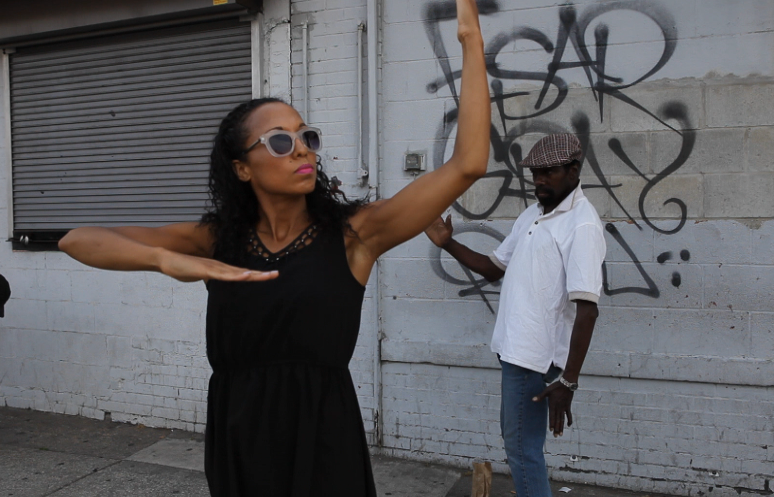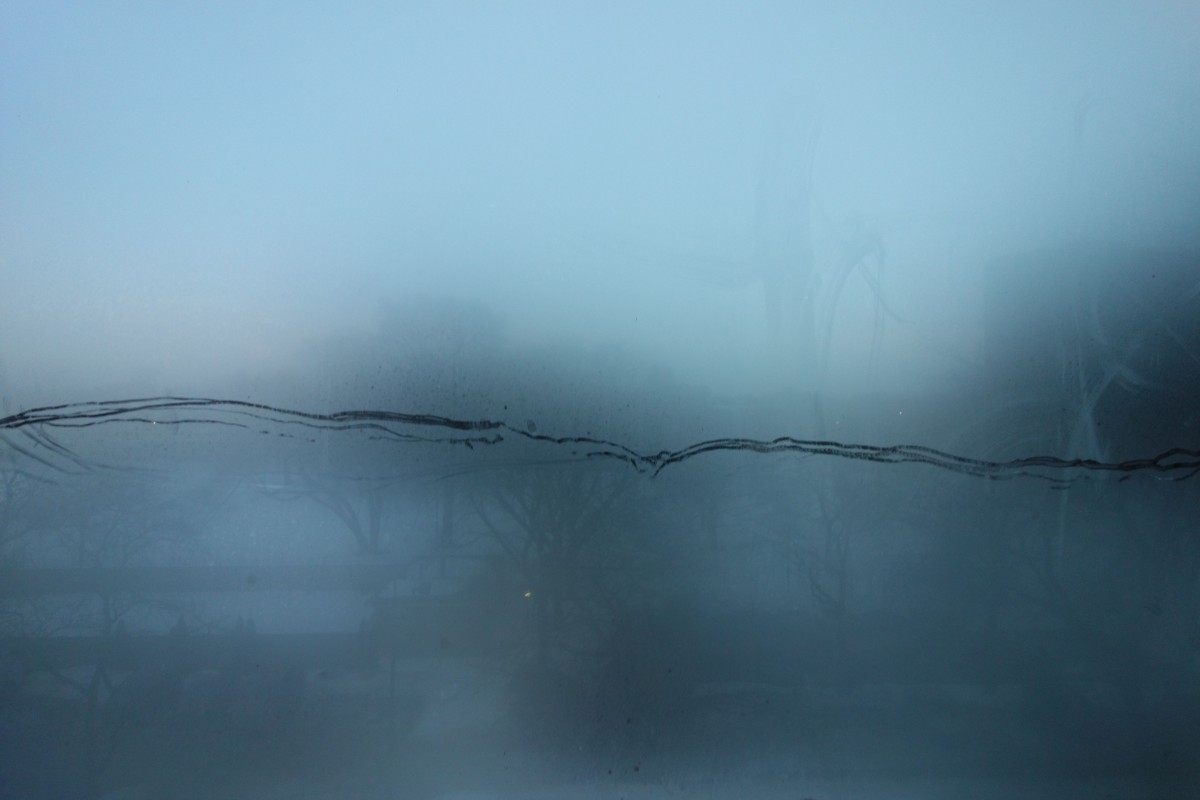On Dance: A Politics of Rhythm
Michael Stone-Richards
The abstract thinker, to whom the question of practical morality is indifferent, has always loved dancing, as naturally as the moralist has hated it.
Arthur Symons, “The World as Ballet,” 1906

Biba Bell, It Never Really Happened, 2015. Photo Print.
I
At the end of February into early March of 2015, there occurred in Detroit an art event that for many of us was of a kind of which one will either say, “I was there,” or, “I was not there.” Biba Bell, dancer-choreographer-scholar – the very image of what the new dance studies since Judson has sought to produce – mounted a choreography called It never really happened (Part One), a site-specific dance made to be executed in a fifth-floor corner apartment of the Pavilion high rise designed by Mies van de Rohe. (Matthew Piper, with our friends at Infinite Mile, produced a long and rich conversation with Bell about the origin of this work and the concepts explored through it, of which we reproduce an edited version in this issue of Detroit Research.1Cf. Matthew Piper, “How it Happened: A Conversation with Biba Bell about her Apartment Dance,” Infinite Mile, no. 16 (April 2015), … The question of where and when the dance began was built into the invitation itself (hence the video of the dance begins with the outside of the building) since there was a strict interval for arrival at the high-rise building and for access to the apartment, where, upon arrival, one was met by a hostess, performed by Nicola Kuperus, who provided drinks and pointed one to the limited seating along two walls, the other two planes of the room being sheet-glass opening onto the nature and sky of Lafayette Park. The mixing of guests and party-talk was also part of the performance – we, as “audience,” would not be told, The performance is about to start – very much like the choreography of party guests in Maya Deren’s great mytho-poetic dance film Ritual in Transfigured Time (black and white, 1946) where the use of slow motion and freeze-frame serves precisely to expose to view the underlying repetition of habits (of greetings and welcome) as already a structuring choreography at once ordinary and latent with ritual force and alterity (imagine, say, the Greek demand for hospitality since one may never know that one is not meeting a god), something signaled in the film’s language by the use of negative light to mark the phenomenon of experience as transition. The appearance of Biba Bell the performer simply signaled the transition to another stage or phase of the dance. We are fortunate in having a recording of the dance available on the Detroit Research website – or at least a partial recording – since not only the dance itself but the sound work composed for the performance would need to be grasped for the fullness of the work and its engagements to be articulated. And what are these engagements? With It never really happened (Part One), Bell made the most astonishing presentation of her work and thought yet: presence of bodies to bodies (the compactness of party-goers, the compactness of sitting on a bench with no protective social space in between guests), post-studio dance, the investigation of architecture, the foregrounding of an aesthetics of domesticity as also an architecture of domesticity (and what could be more domestic and yet intertextual than the witty transposition of Yvonne Rainer’s Hand Movie to a Foot Dance2Cf. Yvonne Rainer, Hand Movie, 1966, available on YouTube at https://www.youtube.com/watch?v=CuArqL7r1WQ. Accessed 08-13-16., and, in the final scene of Bell’s performance consisting of a slow walking movement with the left hand of the dancer moving along the two planes of sheet-glass, the appearance of the trace upon the misted glass of the apartment as signal of many other traces (of negative space, bodies, party detritus). For the closing stages of the dance the hostess, having been led slowly by the principal performer to a place of uneventfulness, sits in stillness and looks on without affect, and it is difficult not to see her as both audience and subject of the dance, at once alienated and engaged, living only in movement. (But what is life if not self-movement?) There was an intensity of movement and presence without, though, the heaviness which can scarce any longer be taken without irony; but above all, the architecture of the compact – situation, room, and consent – left one unable not to feel the affective embodiment of a shared arc of desolation, mourning, celebration, and resignation. Bodies generate metaphorical associations – trans-port – and for this viewer, the ending tracing along steamed-up glass evoked the poetry of clouds in a Baudelaire or the tradition of mono no aware, at the same time that it made one feel the affective and hence social depletion. It was an experience that no one present would have missed, as the compact carried over into re-entering the night of the city of Detroit.

Biba Bell, Who Me House, 2004.
II
Introducing this volume I observed that the mission that Detroit Research has set itself is to situate the recent art practices of Detroit within a national and international setting. Our aim is not simply to capture or to report or describe the current art of the city but to develop a critical language anchored in Detroit’s emerging art practices as the basis of a critical theory of social practice broadly conceived since “life too is a form of art [approached through] the study of places and people.”3Arthur Symons, “Preface,” Plays, Acting, and Music (London: Constable & Company, 1909), viii. The material gathered by Biba Bell On Dance for this volume captures to perfection this ambition in an innovative reflection on a city known for many things – the Motown sound pre-eminently – but not dance, at least experimental art dance, since Bell and her collaborators take dance as this is now understood in the most compelling contemporary – that is, post-Judson – appreciation as intervention, research into acts of historically conditioned forms of social embodiment, articulation, and movement. An excellent example of this conception of dance is Bell’s own work – at once performance, dance, and non-dance4An important aspect of the work of choreographers such as Pina Bausch and Anne-Teresa de Keersmaeker is precisely the question of the shift between … – called Who Me House from 2004 in which the performer, Bell herself, is enframed in a vitrine: the body is framed, and movement is entrained and limited, and the domestic acts of walking and shifting around within a constrained space become the subjects of looking-at (and looking-in running the risk of being looked-through) at the same time that such loaded looking-at (gazing) becomes the subject of the investigation through the dance/performance. At another remove the liminal boundaries between dance, performance, and “mere” movement announce the subject of the work as liminality in the social sphere as the frame removes body and performer from the anchoring of the everyday yet still subject to the gaze from the place of the everyday (the viewers). The conception of dance at work in these studies and interventions gathered by Bell is one in which, as with Who Me House, enframing gives moments and processes of the everyday over to the pressures of exposure. Discontinuity, then, or inter-ruption (into and from), is the mark of this de-constructive dance.

Maya Stovall, Liquor Store Theatre, 2014.
III
In Bell’s essays and interventions in On Dance the work of the great choreographer-dancer Ralph Lemon, for example, along with the Danish Mårten Spångberg,5Cf. Lindsey Winship, “Mårten Spångberg, the Bad Boy of Contemporary Dance,” The Guardian (July 5, 2013), … is situated alongside Detroit choreographer Maya Stovall and artist Hamilton Poe’s photo-essay on “terry2day” and further work on Voguing and Arab-American experimentalism in movement forms. What emerges – and this is especially so in the conversation between Stovall and Bell, and Matthew Piper’s dossier of Bell’s own writings – is the way in which dance grasped as research permits for a new understanding and image of the city, in this case, Detroit, the idea of Detroit as the poet Jim Gustafson famously formulated it. The (social) choreography of Terry captured by photography in “terry2day” is Detroit at a certain angle but also more than this as movement becomes discourse in an expanded materialist conception of dance relative to the City (whose locations, places, and space are conceptually grasped as the negative of theatre forms and space, hence Bell’s preoccupation with what it might mean to practice a post-studio (inter-ruptive, discontinuous) form of dance). For Poe, but also Maya Stovall’s Liquor Store Theatre intervention, this form of dance in the expanded field is a means of grasping the body at the intersection of power and exclusion in order to show culture in transition, or to make visible the contradictory and complex (repressive and negating) movements of power inscribed across corporeality. The new dance studies in which Bell has been formed – the work of Sally Banes, Susan Leigh Foster, Susan Manning, and Bell’s own mentor André Lepecki – grasps dance as a cognitive and methodological medium capable of wide application and generalization (consider, for example, the title of Susan Leigh Foster’s famous anthology Choreographing History6Cf. Susan Leigh Foster, ed., Choreographing History (Bloomington: Indiana University Press, 1995).,7The historiography of such a conception of dance as life itself is long indeed – stretching back to Hindu conceptions of the universe as embodied … indeed, a tool of study where the body of dance is the depository of traces and forces of ideology, history and potentiality. Dance in the most conventional understanding of the art form, shapes forces – of seduction, of vision, of attraction and repulsion – but dance is also, in the larger expanded field of movement off-stage, the image and medium of larger interlocking impersonal forces (attraction and repulsion) of power that shape and direct lives at the unconscious level. This is what Frank Kermode was driving at in his essay on the aestheticism of dance in the 1890s when he observed that “[The Modern Dance] depends always upon the body – upon the power of the body – not to express emotion but to objectify a pattern of sentience.”8Frank Kermode, “Poet and Dancer before Diaghilev,” in What is Dance? Readings in Theory and Criticism, ed. Roger Copeland and Marshall Cohen … This unconscious level can be that of the tacit domain of Edward T. Hall, where, again, the image of dance is no mere image (or metaphor) but medium. As Hall himself wrote in The Dance of Life, “It can now be said with assurance that individuals are dominated in their behavior by complex hierarchies of interlocking rhythms. […] I am convinced that it will ultimately be proved that almost every facet of human behavior is involved in the rhythmic process,”9Edward T. Hall, The Dance of Life (Garden City, N.Y.: Anchor Press, 1983), 141. which is to say that Hall believes that the movement of social life – and life itself – is dance, and so the study of dance a study of the forms of life. The idea of dance explored in these pages is nothing less than a politics of rhythm10It is regrettable that no translation is yet available of what is arguably the most penetrating work on the politics of rhythm, a work of … As I complete the editing of this volume, which is to say, the viewing of artwork and the reading of texts – many times over, like a performance – I have come to a view, I shall not call it an insight, at least I shall not insist on it, namely, that the works of Leni Sinclair (more and more the photographer of Detroit) shares much with the conception of dance at work in Bell’s vision (we would need the mediation of Anna Halprin and Simone Forti to make sense of this), for with the frame necessary to art in the Western tradition there comes in the work of Sinclair and the dance presented in Bell’s collaborators in this volume the multitudinous and various sense of forms of life interlocking, overlapping, dissolving, re-appearing – and resisting. It almost makes one want to re-read Deleuze.
References
